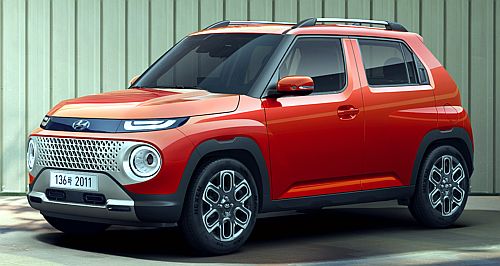More Hyundai hybrids and EVs to come

HYUNDAI will strengthen its electrically enhanced portfolio over the next two years, rolling out at least two new EV SUVs, its first petrol-electric i30 and Kona derivatives, and widening the supply pipeline for its fully electric models.
Speaking to media at the local launch of the Ioniq 6, Hyundai Motor Company Australia’s (HMCA) Direct-to-Consumer senior manager Andrew Stamatakis said that beyond the arrival of new pure-electrics in the form of the Ioniq 6 and the impending Kona EV and hulking Ioniq 7 large SUV, the company would be adding electrified options across the full SUV spectrum.
“By the end of next year, Hyundai is going to have an electrified model in every single SUV segment we operate in,” said Mr Stamatakis.
“Last year, 3.5 percent of Hyundai Australia’s volume was battery electric vehicles. That’s going to continue because we’ve now got two Ioniq vehicles: we’ve got the Ioniq 5 that you all know, and now we’ve got Ioniq 6.
“Towards the end of next year, we’ve got Ioniq 5 N, and then next year we’ve got Ioniq 7, our large SUV battery-electric vehicle. Our path to electrification is an exciting one, and it’s going to be a quick one.”
In 2022, HMCA sold around 700 battery-electric vehicles, split between the Ioniq 5 and Kona EV.
Improvements to supply and allocation plus the addition of the Ioniq 6 means the company is now forecasting an increase in EV sales to a far more substantial 3000 units for 2023, doubling to 6000 units by the end of 2024 after the Ioniq 7 and Ioniq 5 N arrive.
But while that would put total EV sales somewhere between eight and 10 per cent of HMCA’s overall volume, it’s the broader electrification of the Hyundai showroom that may move the meter more.
The Santa Fe already boasts a hybrid option, while the Kona will also gain a hybrid variant later this year for the first time.
HMCA’s pledge to have an electrified (either hybrid or fully electric) model in “every single SUV segment we operate in” by the end of 2024 means even the entry end of the SUV market will have a battery-enhanced Hyundai in it.
However, while there’s no official word on what model will fulfil that role, we do know that it won’t be a Venue variant: a hybrid or battery-electric version of that model doesn’t exist, nor are there plans to introduce one.
The same applies to the Euro-market Hyundai Bayon, which serves as Hyundai’s light SUV entrant in Europe with a trio of petrol engines.
Instead, Hyundai’s Casper ultra-compact hatch is expected to become HMCA’s electric light SUV, with South Korean title Pulse speculating last year that a battery-electric Casper variant is due to launch in Hyundai’s home market by the end of this year.
An Australian release sometime in 2024 certainly seems within the realm of possibility.
As for the mid-sized SUV segment, Hyundai’s Ioniq 5 already provides it with an electrified option to serve that market. However, GoAuto understands that for the medium SUV segment – the largest and most commercially critical in Australia – HMCA isn’t content with having just the one electrified MSUV offering.
The Tucson is already available overseas in right-hand drive (RHD) hybrid form (built at Hyundai’s plant in the Czech Republic), however has previously been written off for an Australian release due to unfavourable exchange rates between the Czech Koruna and Australian Dollar.
However, South Korean production for the Tucson Hybrid is expected to add RHD capacity, opening an avenue for HMCA to offer its own rival to the dominant Toyota RAV4 hybrid, not to mention newer contenders like the Mitsubishi Outlander PHEV and Nissan X-Trail e-Power.
In South Korean form, the Tucson Hybrid produces 169kW/264Nm of combined petrol/electric output from its 132kW 1.6-litre turbo petrol four-piston engine and single 44kWelectric motor, with a claimed average of 6.2L/100km in two-wheel drive form, or 6.8L/100km as an all-wheel drive.
And that would give HMCA a breadth of powertrain choice in both the small and medium SUV segments that most of its rivals would struggle to match, with conventional combustion engines sitting alongside hybrids and pure EVs.
It’s a strategy that could extend to the upper-large SUV segment too, if HMCA has its way, though a hybrid partner to the petrol-only Palisade and EV-only Ioniq 7 has yet to materialise in the product plan.
“I think if we get the Kona model, right, then it's a reflection of what could be - but we still need to convince people that it's the next the right next step,” HMCA chief operating officer John Kett to GoAuto.
However, official confirmation of what that next step might by has yet to be made.
“We can't make any announcements on Tucson and what we may do in the future with Palisade, we can't make any announcements that we want on those products,” he said.
The i30 will gain a hybrid option for the first time, finally giving Hyundai customers a true alternative to the Corolla hybrid.
“It’ll be coming out in the sedan and will be later this year, but it’s an opportunity for us to extend that [i30 range],” said Mr Kett.
“Whether it substitutes the existing petrol version or not, whether it’s incremental to the petrol version or whether it supplements any change in preferences from a hatch – over time we know that people are shifting from that segment – I just think it opens up an opportunity.
“We’re looking at it as a transition to a carbon neutrality state and it’s a natural step to take. We think in the short term that i30 Hybrid it will be incremental, but I think it’s been proven that over time people just naturally gravitate to it (hybrids).”